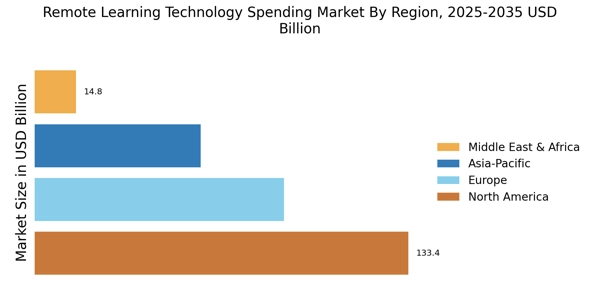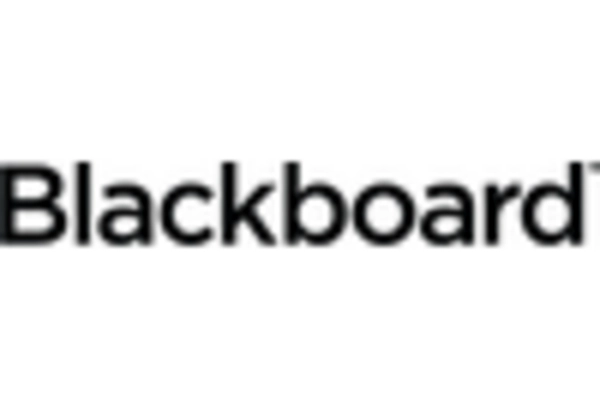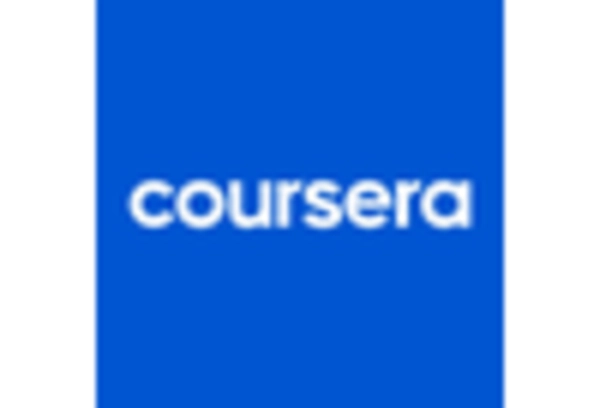Expansion of Online Course Offerings
The Remote Learning Technology Spending Market is experiencing a significant expansion in online course offerings, driven by the increasing acceptance of digital education. Educational institutions are diversifying their course catalogs to include a wide range of subjects, catering to the growing demand for accessible learning options. Recent data indicates that the online education market is expected to surpass 300 billion dollars by 2025. This expansion not only attracts a broader audience but also encourages institutions to invest in robust learning management systems and content delivery platforms. As a result, the Remote Learning Technology Spending Market is likely to see sustained growth as more learners seek flexible and diverse educational opportunities.
Increased Focus on Skill Development
The Remote Learning Technology Spending Market is witnessing a heightened emphasis on skill development, particularly in response to evolving job market demands. Organizations are increasingly investing in remote learning technologies to provide employees with the necessary skills to thrive in a competitive landscape. Data indicates that around 60% of companies are allocating budgets specifically for upskilling and reskilling initiatives. This trend is not only limited to corporate training but extends to educational institutions that aim to equip students with relevant skills for future careers. As a result, the Remote Learning Technology Spending Market is likely to expand as more entities recognize the importance of continuous learning and skill enhancement.
Growing Adoption of Artificial Intelligence
The Remote Learning Technology Spending Market is significantly influenced by the growing adoption of artificial intelligence (AI) in educational settings. AI technologies are being integrated into learning platforms to provide personalized experiences, automate administrative tasks, and enhance learner engagement. Recent statistics suggest that the use of AI in education is projected to reach a market value of over 6 billion dollars by 2027. This integration not only streamlines operations but also allows for tailored learning paths that cater to individual student needs. Consequently, the Remote Learning Technology Spending Market is likely to benefit from this technological advancement as institutions seek to leverage AI for improved educational outcomes.
Rising Demand for Flexible Learning Solutions
The Remote Learning Technology Spending Market is experiencing a notable increase in demand for flexible learning solutions. As educational institutions and organizations seek to accommodate diverse learning styles and schedules, the need for adaptable platforms has surged. According to recent data, approximately 70% of educational institutions are investing in technologies that support asynchronous learning. This shift allows learners to access materials at their convenience, thereby enhancing engagement and retention. Furthermore, the rise of remote work has prompted companies to invest in training solutions that can be accessed from anywhere, further driving spending in this sector. The Remote Learning Technology Spending Market is thus poised for growth as stakeholders recognize the value of flexibility in education.
Government Initiatives Supporting Remote Learning
The Remote Learning Technology Spending Market is positively impacted by various government initiatives aimed at promoting remote learning. Governments are increasingly recognizing the importance of digital education and are allocating funds to enhance technological infrastructure in schools and universities. Recent reports indicate that several countries have introduced grants and subsidies to support the adoption of remote learning technologies. These initiatives not only facilitate access to quality education but also encourage institutions to invest in innovative solutions. As a result, the Remote Learning Technology Spending Market is expected to thrive as government support bolsters the development and implementation of remote learning technologies.


















Leave a Comment